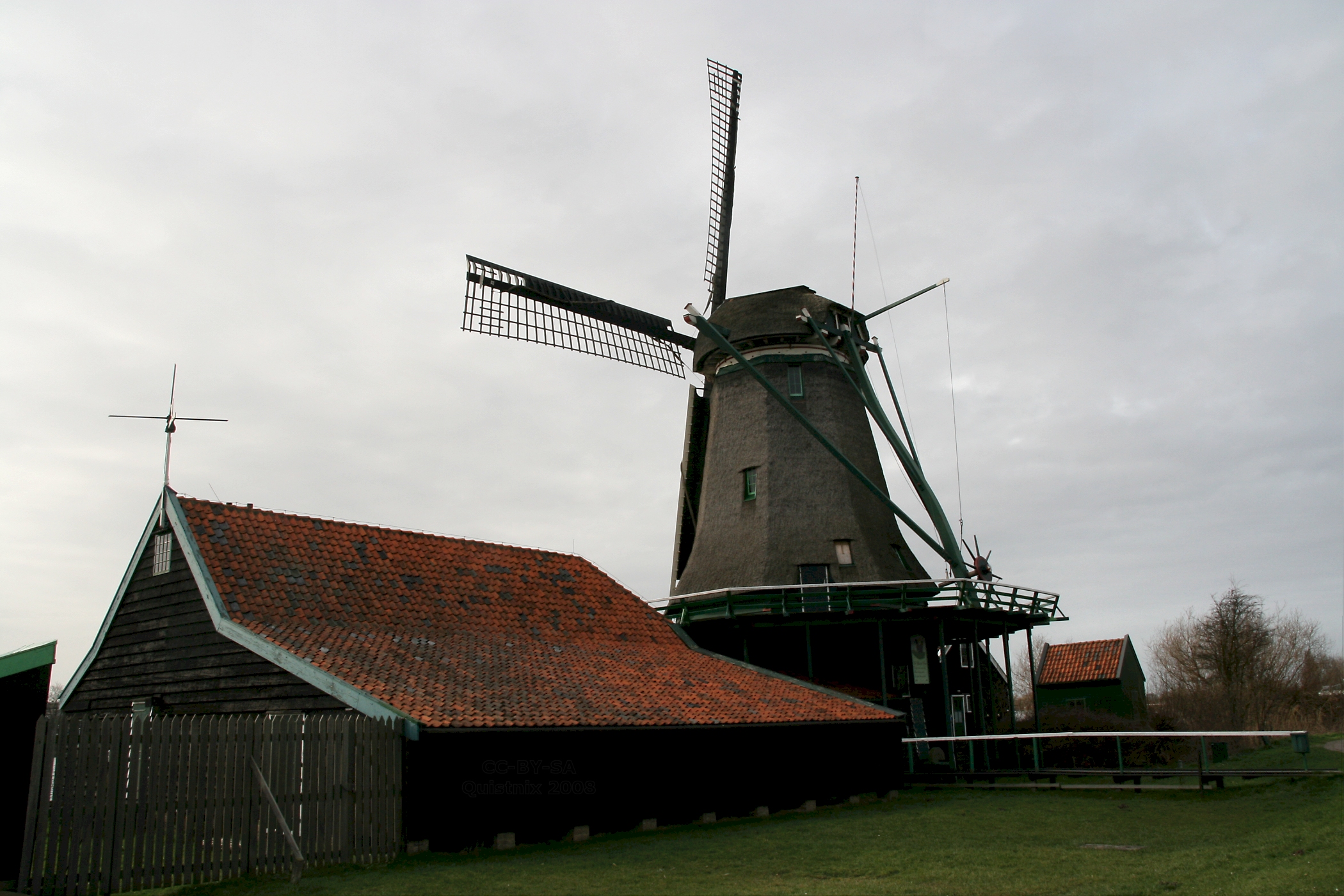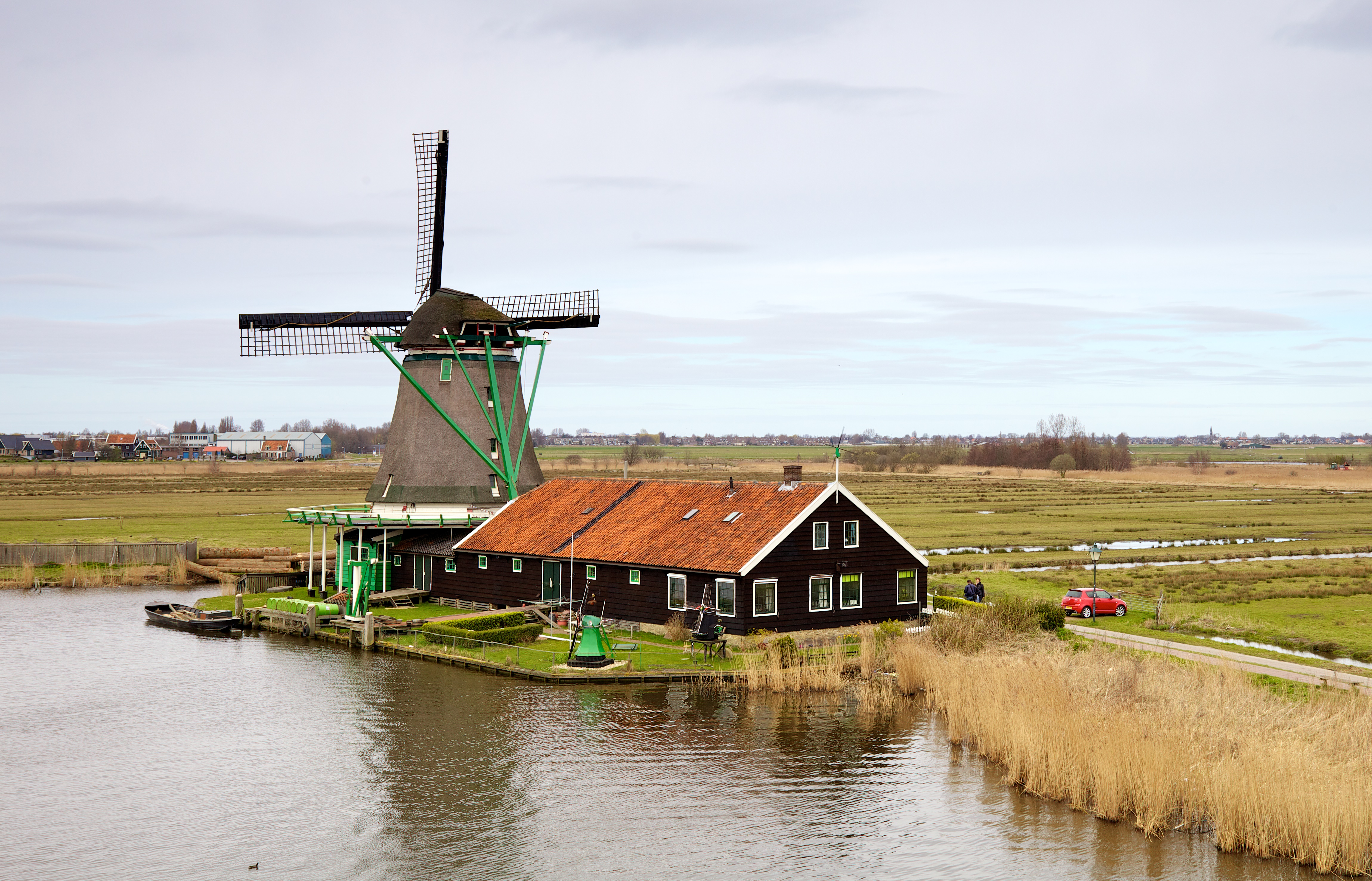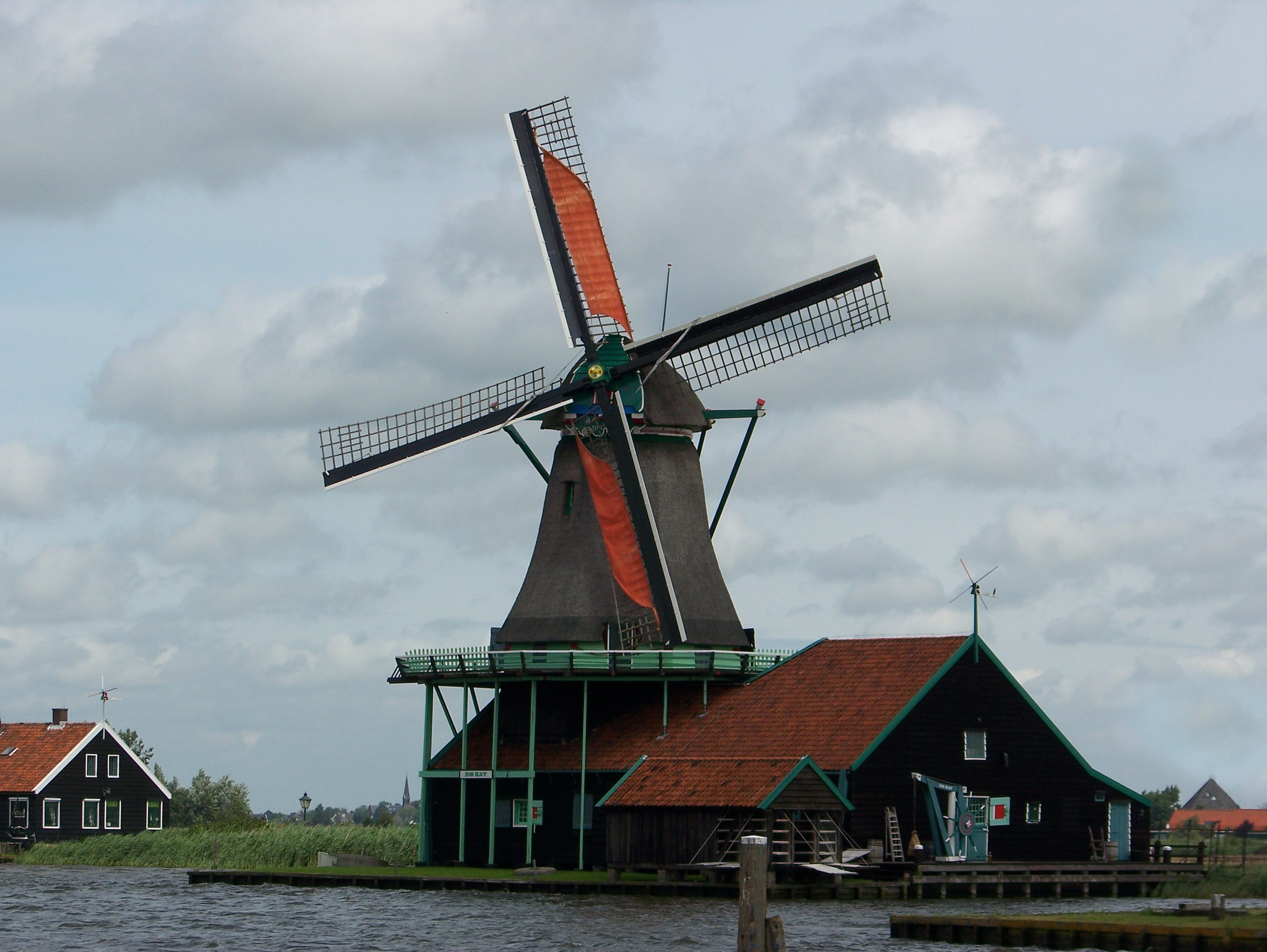|
Zaanse Schans
Zaanse Schans () is a neighbourhood of Zaandam, near Zaandijk, Netherlands. It is best known for its collection of windmills and wooden houses that were relocated here from the wider region north of Amsterdam for preservation. From 1961 to 1974, old buildings from all over the region known as the Zaanstreek were relocated using lowboy trailers to the Zaanse Schans. Two of the windmills in the Zaanse Schans are preserved in their original site where they were first constructed, and therefore don't make up part of the relocated structures. The Zaans Museum, established in 1994, near the first Zaanse Schans windmill, is located south of the neighbourhood. This architectural reserve for Zaanse timber construction is a protected village scene because of its architectural-historical and landscape value. It developed into an international tourist destination with several million visitors every year: in 2016, there were 1.8 million, in 2017 – 2.2 million. Etymology and history Zaanse S ... [...More Info...] [...Related Items...] OR: [Wikipedia] [Google] [Baidu] |
Neighbourhood
A neighbourhood (British English, Irish English, Australian English and Canadian English) or neighborhood (American English; American and British English spelling differences, see spelling differences) is a geographically localised community within a larger city, town, suburb or rural area, sometimes consisting of a single street and the buildings lining it. Neighbourhoods are often social communities with considerable face-to-face interaction among members. Researchers have not agreed on an exact definition, but the following may serve as a starting point: "Neighbourhood is generally defined spatially as a specific geographic area and functionally as a set of social networks. Neighbourhoods, then, are the Neighbourhood unit, spatial units in which face-to-face social interactions occur—the personal settings and situations where residents seek to realise common values, socialise youth, and maintain effective social control." Preindustrial cities In the words of the urban sch ... [...More Info...] [...Related Items...] OR: [Wikipedia] [Google] [Baidu] |
European Route Of Industrial Heritage
The European Route of Industrial Heritage (ERIH) is a tourist route of the most important industrial heritage sites in Europe. This is a tourism industry information initiative to present a network of industrial heritage sites across Europe. The aim of the project is to create interest for the common European heritage of the Industrialisation and its legacy. ERIH also wants to promote regions, towns and sites showing the industrial history and market them as visitor attractions in the leisure and tourism industry. History The concept of using a European Route of Industrial Heritage was born in 1999; it was recognised there had been no single event to shape the European landscape greater than the industrial revolution. That changed the working culture of all Europeans, and gave common experiences to communities across Europe whether it be deep mine coal working in the Rühr or South Wales. Four countries, Great Britain, Belgium, Germany and the Netherlands successfully applied for ... [...More Info...] [...Related Items...] OR: [Wikipedia] [Google] [Baidu] |
Museums In North Holland
A museum ( ; plural museums or, rarely, musea) is a building or institution that cares for and displays a collection of artifacts and other objects of artistic, cultural, historical, or scientific importance. Many public museums make these items available for public viewing through exhibits that may be permanent or temporary. The largest museums are located in major cities throughout the world, while thousands of local museums exist in smaller cities, towns, and rural areas. Museums have varying aims, ranging from the conservation and documentation of their collection, serving researchers and specialists, to catering to the general public. The goal of serving researchers is not only scientific, but intended to serve the general public. There are many types of museums, including art museums, natural history museums, science museums, war museums, and children's museums. According to the International Council of Museums (ICOM), there are more than 55,000 museums in 202 count ... [...More Info...] [...Related Items...] OR: [Wikipedia] [Google] [Baidu] |
Wind Pump
A windpump is a type of windmill which is used for pumping water. Windpumps were used to pump water since at least the 9th century in what is now Afghanistan, Iran and Pakistan. The use of wind pumps became widespread across the Muslim world and later spread to China and India. Windmills were later used extensively in Europe, particularly in the Netherlands and the East Anglia area of Great Britain, from the late Middle Ages onwards, to drain land for agricultural or building purposes. Simon Stevin's work in the ''waterstaet'' involved improvements to the sluices and spillways to control flooding. Windmills were already in use to pump the water out, but in ''Van de Molens'' (''On mills''), he suggested improvements, including the idea that the wheels should move slowly, and a better system for meshing of the gear teeth. These improvements increased the efficiency of the windmills used to pump water out of the polders by three times. He received a patent on his innovation in 158 ... [...More Info...] [...Related Items...] OR: [Wikipedia] [Google] [Baidu] |
De Bonte Hen, Zaandam
De Bonte Hen (''The Spotted Hen'') is the name of an oil mill, located in the Zaanse Schans, Netherlands. De Bonte Hen is the northernmost of the mills in Zaanse Schans. The original mill was built in 1693. It was rebuilt In 1935 and restored in 1975. Since then, the mill has been operated weekly on a voluntary basis. It contains original oil cellars for the storage of oil made at the mill. See also * De Gekroonde Poelenburg, Zaandam * De Huisman, Zaandam * De Kat, Zaandam * De Os, Zaandam * De Zoeker, Zaandam External links De Bonte Henat the website of the Zaanse Schans Zaanse Schans () is a neighbourhood of Zaandam, near Zaandijk, Netherlands. It is best known for its collection of windmills and wooden houses that were relocated here from the wider region north of Amsterdam for preservation. From 1961 to 1974, o ... De Bonte Henat the website of {{DEFAULTSORT:Bonte Hen Windmills in North Holland Populated places in North Holland Smock mills in the Nether ... [...More Info...] [...Related Items...] OR: [Wikipedia] [Google] [Baidu] |
Het Klaverblad, Zaandam
Het Klaverblad (''The Cloverleaf'') is a small wooden saw mill, located in the Zaanse Schans, in the municipality of Zaanstad Zaanstad () is a Dutch municipality in the province of North Holland, situated northwest of Amsterdam. Its main city is Zaandam. It is part of the conurbation and metropolitan area of Amsterdam. It had a population of in . Topography Popul .... The mill was built by Ru Pos on the site of the previous KROMO warehouse. This private initiative was turned into foundation "Het Klaverblad" with the purpose of building, running and maintaining the sawmill. The sails of the mill first turned in 2005. See also * De Kat * De Huisman * De Os * De Zoeker * De Gekroonde Poelenburg * De Bonte Hen External links De website van de molen {{DEFAULTSORT:Klaverblad Windmills in North Holland Hollow post mills in the Netherlands Windmills completed in 2005 Zaandam ... [...More Info...] [...Related Items...] OR: [Wikipedia] [Google] [Baidu] |
De Zoeker, Zaandam
De Zoeker (''The Seeker'') is the name of an oil windmill, located in the Zaanse Schans, Zaanstad. Its purpose is to press seeds such as linseed and rapeseed into vegetable oil. It is the only oil mill still in operation, and is one of five remaining oil mills in the area. The mill was built in 1672 in Zaandijk Zaandijk () is a town in the municipality of Zaanstad, province of North Holland, Netherlands. It lies about 11 kilometres (6.8 miles) northwest of Amsterdam and had a population of 8,686 in 2017.Statistics Netherlands (CBS), ''Statline: Kern .... The mill continued with few interruptions until 1968, when it was moved to the Schans. The mill is owned by the . retrieved October 30, 2012 See also *[...More Info...] [...Related Items...] OR: [Wikipedia] [Google] [Baidu] |
De Os, Zaandam
De Os () is an oil windmill in the Zaanse Schans, Zaanstad. Between the saw mills Het Jonge Schaap and Het Klaverblad is the hull of the oil mill De Os. The mill was built in 1663 and is one of the oldest industrial windmills in the Zaan. Until 1916 the mill was operating on wind power. In that year, the hood and wings were removed; the Os was converted to a warehouse. The barns are now occupied by the mill. The mill body was restored in recent years. See also * De Kat, Zaandam * De Huisman, Zaandam * De Zoeker, Zaandam De Zoeker (''The Seeker'') is the name of an oil windmill, located in the Zaanse Schans, Zaanstad. Its purpose is to press seeds such as linseed and rapeseed into vegetable oil. It is the only oil mill still in operation, and is one of five rema ... * De Gekroonde Poelenburg, Zaanse Schans * Het Jonge Schaap, Zaandam External links Een fotoreportage met interieurfoto's* {{DEFAULTSORT:Os Windmills in North Holland Smock mills in the Netherlands ... [...More Info...] [...Related Items...] OR: [Wikipedia] [Google] [Baidu] |
Het Jonge Schaap, Zaandam
Het Jonge Schaap (; ''The young sheep'') is the name of a wooden wind powered sawmill, located in the Zaanse Schans, in the municipality of Zaanstad. The original mill was built in 1680 and demolished in 1942. Between 2005 and 2007, a replica of the mill at the Zaanse Schans was built, between the mills " De Zoeker" and " De Bonte Hen". The construction of the replica was based on detailed drawings Anton Sipman had made before the original mill was demolished. File:Het Jonge Schaap.JPG, Het Jonge Schaap (November 2007) File:Zaanse Schans molen Het Jonge Schaap.jpg, Het Jonge Schaap (maart 2008) File:Zaanse Schans molen Het Jonge Schaap - boomstam zagen.jpg, Cutting a tree trunk File:Zaanse Schans molen Het Jonge Schaap - boomstam zagen 2.jpg, Same trunk, seen from the other side See also * De Kat, Zaandam * De Huisman, Zaandam * De Os, Zaandam * De Zoeker, Zaandam De Zoeker (''The Seeker'') is the name of an oil windmill, located in the Zaanse Schans, Zaanstad. Its p ... [...More Info...] [...Related Items...] OR: [Wikipedia] [Google] [Baidu] |
De Kat, Zaandam
De Kat is the only remaining working windmill in the world which makes paint. The mill is in the Zaanse Schans, Zaanstad. The original mill 'De Kat' was built in 1646 as an oil mill. In 1782 it was destroyed by fire but was rapidly rebuilt again. The mill was in use until 1904 and then was partially demolished. In 1960 the eight-sided paint mill 'De Duinjager' was removed from its former position owing to urban development and placed on top of the old storehouse of 'De Kat'. The mill is again grinding raw materials such as chalk to make pigments for paints in the traditional way. The mill is owned by the Vereniging De Zaansche Molen. Gallery File:Zaanse Schans molen De Kat.jpg, View of the mill File:Zaanse Schans molen De Kat droogschuurtje.jpg, Drying shed for chalk File:Zaanse Schans molen De Kat klompen bij de deur.jpg, Clogs at the door File:Zaanse Schans verfmolen De Kat - kantstenen.jpg, Side stones File:Zaanse Schans verfmolen De Kat - pigmenttonnen.jpg, Pigment ... [...More Info...] [...Related Items...] OR: [Wikipedia] [Google] [Baidu] |
De Gekroonde Poelenburg, Zaandam
De Gekroonde Poelenburg (''The Crowned Poelenburg'') is a paltrok mill in Zaandam, Netherlands which has been restored to working order. Like all Dutch ''paltrok mills'' it is a windpowered sawmill. The mill is listed as a Rijksmonument, number 40093. It is located at the Zaanse Schans in a group of several historic industrial windmills. History The history of ''De Gekroonde Poelenburg'' is rather complicated involving several distinct windmills. The first windmill on the original location of the first ''De Poelenburg'' in Zaandam-Oost was mentioned in 1733. It was named after its owner Pieter Jochemsz. Poelenburg. This mill burned down in 1903 and was replaced by a windmill from Koog aan de Zaan called ''De Locomotief'' (''The Locomotive'') which was renamed to ''De'' Gekroonde ''Poelenburg'' after the move. ''De Locomotief'' was newly built in Koog aan de Zaan in 1867 to replace the 200-year-old ''De Groene Jager'' (''The Green Hunter'') that had to be dismantled for the constr ... [...More Info...] [...Related Items...] OR: [Wikipedia] [Google] [Baidu] |
De Huisman, Zaandam
De Huisman is a small octagonal mill at the Zaanse Schans in the Zaanstad, and currently makes mustard Mustard may refer to: Food and plants * Mustard (condiment), a paste or sauce made from mustard seeds used as a condiment * Mustard plant, one of several plants, having seeds that are used for the condiment ** Mustard seed, seeds of the mustard p .... 'De Huisman' has been located on the Zaanse Schans since 1955, next to the warehouse 'De Haan'. The mill was probably built in 1786 on the ''Blauwe Pad'' ("Blue Path", now "Claude Monet street") in Zaandam. The mill has functioned as a snuff mill (milling tobacco), a mustard mill, and a saw mill. At the Zaanse Schans, the mill was converted again into a mustard mill, though it mills the mustard seeds in a modern, not wind-operated way. There are advanced plans for the mill to be restored to a traditional mustard mill, and to give the public the opportunity to visit the mill. The mill is owned by the Vereniging De Zaansche Molen. ... [...More Info...] [...Related Items...] OR: [Wikipedia] [Google] [Baidu] |








.jpg)